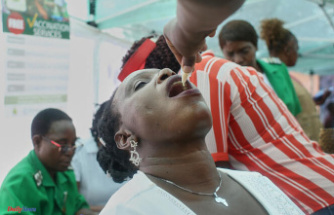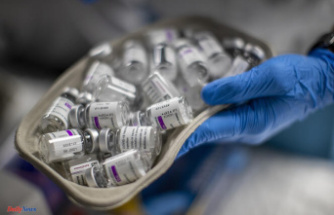Five, four, three, two, one… The final count of the DDO (director of operations) resounds in the various observation posts of the Guiana Space Center, in Kourou. The relaxed atmosphere that reigned over the European spaceport in recent days has now given way to a deafening silence, and reflects the pressure of the scientists and engineers involved in this mission, their eyes riveted on the Ariane 5 rocket. weird feeling, a mixture of nervousness, excitement and impatience,” says Claire Vallat, an ESA operations scientist who has worked on this mission for eight years.
Smoke, then flames, and the rocket takes off to the rhythm of "go Juice" launched by the public. A few seconds later, all the spectators feel the powder crackle in their ribcage and the ground shake. Some diffuse applause is already heard, but we are still waiting to know if the launcher is taking an optimal trajectory.
“Nominal trajectory. These two words from Jean-Luc Mestre, at the helm of the operation, describe the faces of the public, who catch their breath. It must be said that this mission left no room for error. No margin in the launch window was possible, the rocket absolutely had to take off at 9:15 minutes and 1 second, local time. This is also what had earned him a postponement on Thursday, due to bad weather.
“It's a question of alignment of the planets and celestial mechanics for an optimized trajectory, explains Manuela Baroni, engineer at ESA. Without this precision, the mission would be degraded, the fuel missing and the scientific elements reported insufficient.
" We left ! cries Claire Vallat, her eyes wet, in FaceTime with her colleagues who remained in Europe. If tears are raining down on Toucan, the rooftop shared by journalists and mission engineers to observe the take-off of the rocket, it's because Juice has been prepared for more than ten years by these teams. "Some have put their lives on hold for years for this project... It's our baby," says the scientist.
The mission goal is ambitious: send a probe to explore Jupiter and its three large icy moons: Ganymede, Callisto and Europa. The main challenge of this space expedition led by ESA is to study the habitability of the Jovian system. There is no question here of seeing if we could build housing estates there to unclog the Earth, but rather of "knowing if in the liquid oceans of these moons life could exist", specifies Francis Rocard, astrophysicist in charge of the solar system exploration program at Cnes (National Center for Space Studies). And therefore to verify that a number of conditions are met, such as "confirmation of the existence of liquid water, the presence of energy for life to appear and that of organic molecules".
For several days, in Kourou, there was agitation around the last preparations. Actor Mathieu Kassovitz, astronaut Claudie Haigneré, the first woman to have been in space, Thomas Pesquet or even Philippe of Belgium, King of the Belgians… Beautiful people paraded at the Guiana Space Center to attend the beginnings of the penultimate launch of Ariane.
Among them, the delicate stage of the "roll-out", this moment when the rocket is transported from its assembly building to its launch pad, from where it has just been sent into orbit. And it was a classic blue semi-trailer that was responsible for moving the 700 tonnes of Ariane 5. "For about an hour, the launcher travels 2.8 km, at a maximum of 6 km/h, specifies Rüdiger Albat , head of the Ariane 5 programs at the European Space Agency (ESA). Drops have surely beaded on the forehead of its driver, "who towed here a few billion euros behind him", he laughs.
A few minutes after launch, a new key step: the separation of the probe, which must continue on its way to Jupiter. "Juice separation confirmed," corroborates the DDO. The applause erupts once again.
But before we can reveal the secrets of Jupiter's icy moons, a long journey awaits the Juice satellite. Never had ESA and Cnes, stakeholders in the mission, ventured so far to explore a celestial body. Jupiter is between 588 and 928 million kilometers from Earth, so the journey is expected to take more than eight years. The difficulties of the mission are therefore quite equal to its ambition. "It's a major technical challenge as the environments crossed during all these years will be extreme", underlines Carole Larigauderie, Juice project manager for Cnes.
Among the constraints to overcome, the probe will have to withstand phenomenal temperature differences on its way. On the side of Venus, next to which it will pass, it is very hot, around 250°C, while, when arriving towards Jupiter, the satellite will be exposed to -230°C. "It's as if you put a piece of plastic in the freezer and then immerse it in hot water, it could go wrong, illustrates the scientist. We have therefore prepared the materials for this, tested and retested the elasticities, to check that nothing can break. We also coated this probe with a multi-layer cover, made of an alloy designed to ensure that the core of the probe remains at a stable temperature and does not damage the tools it houses. A silver garment, unlike most of the other golden satellites, earning her the nickname "silver beauty".
Another issue: Jupiter has the highest radiation belts in the solar system. “To deal with these magnetic emissions, you have to physically shield yourself. The electronics, which are the most sensitive materials, are placed in sarcophagi shielded with lead. We also choose radiation-hardened electronic components, which have been exposed to that,” continues Carole Larigauderie.
But the biggest challenge of this mission lies in the technical issues related to the management of a satellite at such a distance from the Earth… and from the Sun. "When we're around Ganymede, we'll be 1 billion miles from Earth. ESA has therefore designed a huge 2.5m antenna, which will turn towards the Earth to give it all the scientific data and vice versa, listen for instructions from Earth, and a powerful computer, capable of solving problems independently," explains the Cnes engineer. “Also, when we are in the Jovian system, we will receive 25 times less sunlight than if we were on Earth. To make up for this enormous deficit, the size of the solar panels is increased, which are 85 square meters in area, and have a wingspan of 27 meters, almost the length of a basketball court. »
Thirty minutes after the successful launch, joy roams the 750 square kilometers of the Guiana Space Center. Next appointment for Ariane 5: June 2023, during its last launch, to see it bow out, with on board the Eutelsat 10B telecommunications satellites and that of the General Directorate of Armaments Syracuse 4B. What about the Juice mission? “The coolest is yet to come, with a climax in 2031, for the arrival of the first scientific results, Claire Vallat is already impatient. See you in eight years! »












